The framework comes with a set of guidelines for applying the framework. The guidelines aim to enhance the usability, correctness, and understandability of models in the three modeling views and to improve the overall consistency and effectiveness of the framework. The guidelines are grouped into
different categories according to the concern they address, namely Elicitation Guidelines, Syntax Guidelines, and Naming Guidelines. We expect these guidelines to extend in future.
Elicitation Guidelines aim to facilitate elicitation of various modeling elements in the three views.
G-1 Elicitation of Strategic Goals. Strategic business goals can be elicited through a variety of sources and approaches such as interviews, strategic planning documents, mission and vision statements, enterprise policies, and document analysis to extract business goals. Following keywords usually suggest existence of a goal: improve, increase, decrease, achieve, make, maintain, ensure, provide, and accomplish. Following figure shows an example:
 G-2 Refinement of Strategic Goals. One can ask How are we achieving this? about a set of initially identified goals in order to refine and elicit lower goals in the hierarchy. Following figure shows an example:
G-2 Refinement of Strategic Goals. One can ask How are we achieving this? about a set of initially identified goals in order to refine and elicit lower goals in the hierarchy. Following figure shows an example:
 G-3 Refinement of Strategic Goals. By asking How else can we achieve this? about each goal one can identify alternative goals at the lower level (i.e., OR decompositions). This will help ensure that you are capturing alternative ways of achieving each goal. Following figure shows an example:
G-3 Refinement of Strategic Goals. By asking How else can we achieve this? about each goal one can identify alternative goals at the lower level (i.e., OR decompositions). This will help ensure that you are capturing alternative ways of achieving each goal. Following figure shows an example:
 G-4 Abstraction of Strategic Goals to Higher Levels. One can ask Why are we doing this? about a set of initially identified goals in order to elicit higher goals in the hierarchy. Following figure shows an example:
G-4 Abstraction of Strategic Goals to Higher Levels. One can ask Why are we doing this? about a set of initially identified goals in order to elicit higher goals in the hierarchy. Following figure shows an example:
 G-5 Elicitation of Situations. SWOT analysis documentations such as SWOT matrix can be used to identify and populate relevant situations in your model. SWOT stands for Strengths (internal factor, favorable impact), Weaknesses (internal factor, unfavorable impact), Opportunities (external factor, unfavorable impact), and Threats (external factor, unfavorable impact).
G-5 Elicitation of Situations. SWOT analysis documentations such as SWOT matrix can be used to identify and populate relevant situations in your model. SWOT stands for Strengths (internal factor, favorable impact), Weaknesses (internal factor, unfavorable impact), Opportunities (external factor, unfavorable impact), and Threats (external factor, unfavorable impact).
G-6 Keywords for Elicitation of Decision Goals. Decision Goals can be elicited from a variety of sources. While reviewing documents or interview notes and recordings, following keywords suggest existence of a Decision Goal: select, determine, pick, choose, resolve, judge, and conclude.
G-7 Keywords for Elicitation of Question Goals. While reviewing documents or interview notes and recordings, following keywords suggest existence of a Question Goal: find, understand, investigate, examine, and know.
G-8 Use of Process Models for Elicitation of Decision Goals. Decisions are made by actors (humans or software agents) at all levels of an enterprise. They are choice points within execution of some ongoing process. If process models are available (e.g., BPMN models), Decision Goals can be elicited from them (e.g., activities that are just before a diverging Gateway). Following figure shows an example of this guideline in an insurance claim approval process:
 G-9 Use of Data Models for Elicitation of Questions Goal Topics. Each Question Goal is associated with a topic. The topic of Question Goals at the lowest level of the model can correspond to set of entities and relationships from the database schema and/or entity-relationship model. This appears in terms a subset of entityrelationship/database schema diagram. Following figure shows an example:
G-9 Use of Data Models for Elicitation of Questions Goal Topics. Each Question Goal is associated with a topic. The topic of Question Goals at the lowest level of the model can correspond to set of entities and relationships from the database schema and/or entity-relationship model. This appears in terms a subset of entityrelationship/database schema diagram. Following figure shows an example:
 G-10 Use of Data Warehouse Schemas for Elicitation of Question Goal Topics. In the presence of data warehouse schemas (e.g., snowflake schema), the topics of Question Goals can be extracted from the measures in the fact table and (part of) its associated dimensions. Following figure provides an example of this guideline for elicitation of two Question Goals:
G-10 Use of Data Warehouse Schemas for Elicitation of Question Goal Topics. In the presence of data warehouse schemas (e.g., snowflake schema), the topics of Question Goals can be extracted from the measures in the fact table and (part of) its associated dimensions. Following figure provides an example of this guideline for elicitation of two Question Goals:
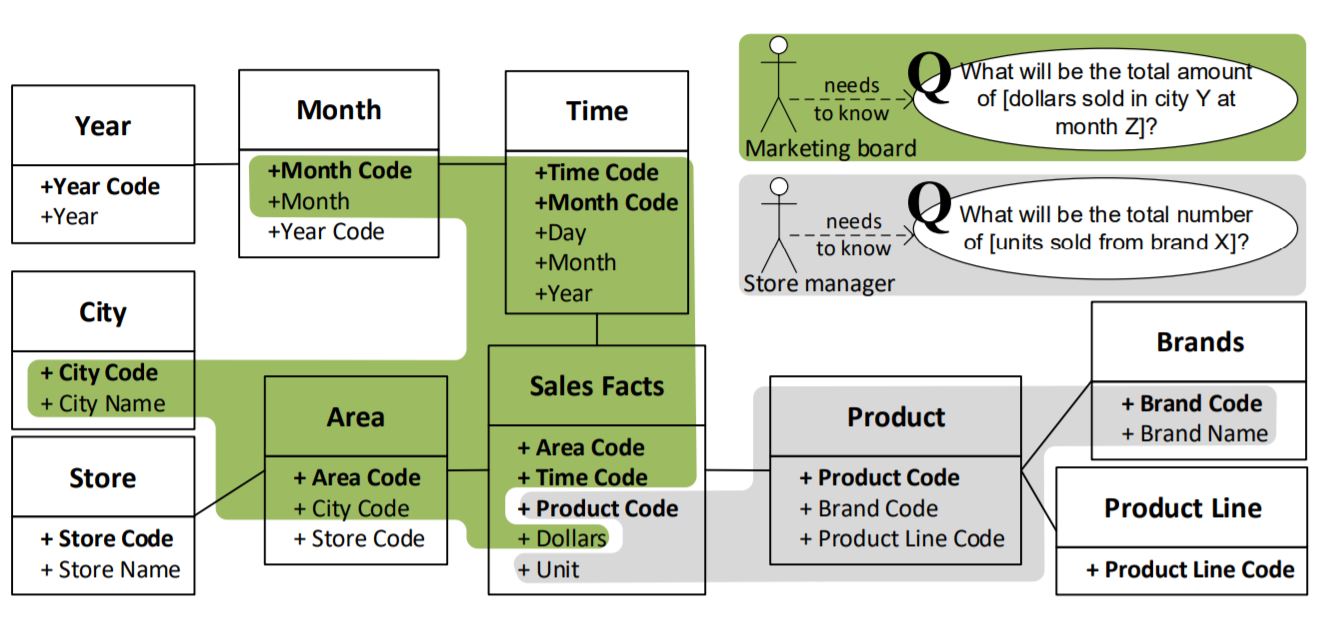 G-11 User-Story Templates. User-story templates can facilitate elicitation of elements in the Business View. Following figure shows two templates along with examples to support elicitation of Decision Goals and Question Goals. These templates represent decision activities from the perspective of an actor (part A) and express their needs-to-know for making those decisions (part B). Examples are for the retail domain:
G-11 User-Story Templates. User-story templates can facilitate elicitation of elements in the Business View. Following figure shows two templates along with examples to support elicitation of Decision Goals and Question Goals. These templates represent decision activities from the perspective of an actor (part A) and express their needs-to-know for making those decisions (part B). Examples are for the retail domain:
 G-12 Use of Actor-Goal-Question-Decision (AGQD) Models. In some cases, depending on availability and commitment of stakeholders, it might be easier and more effective to start the Business View modeling by creating an AGQD model. These models are simple, abstract representations of who needs to know what and why. Following figure shows an example:
G-12 Use of Actor-Goal-Question-Decision (AGQD) Models. In some cases, depending on availability and commitment of stakeholders, it might be easier and more effective to start the Business View modeling by creating an AGQD model. These models are simple, abstract representations of who needs to know what and why. Following figure shows an example:
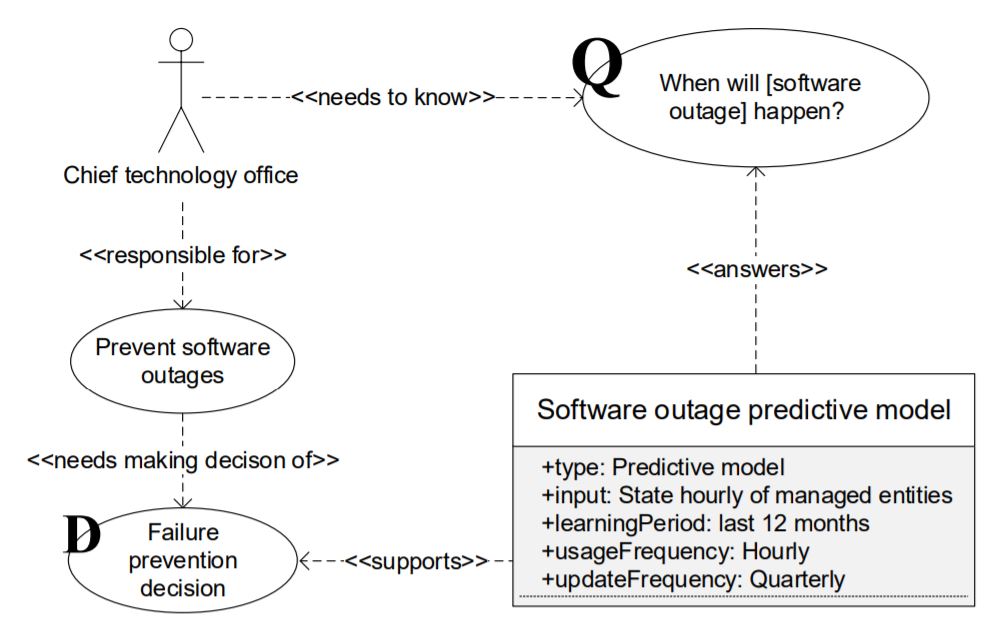 G-13 Refinement of Analytics Goals. Means-end relationships should be used to connect Algorithms to Analytics Goals. In doing that, existing Algorithms Catalogues can be used extensively to pre-populate Analytics Design View models. The catalogues codify and bring the relevant know-how knowledge to the attention of the project team. Following figre shows an example of this:
G-13 Refinement of Analytics Goals. Means-end relationships should be used to connect Algorithms to Analytics Goals. In doing that, existing Algorithms Catalogues can be used extensively to pre-populate Analytics Design View models. The catalogues codify and bring the relevant know-how knowledge to the attention of the project team. Following figre shows an example of this:
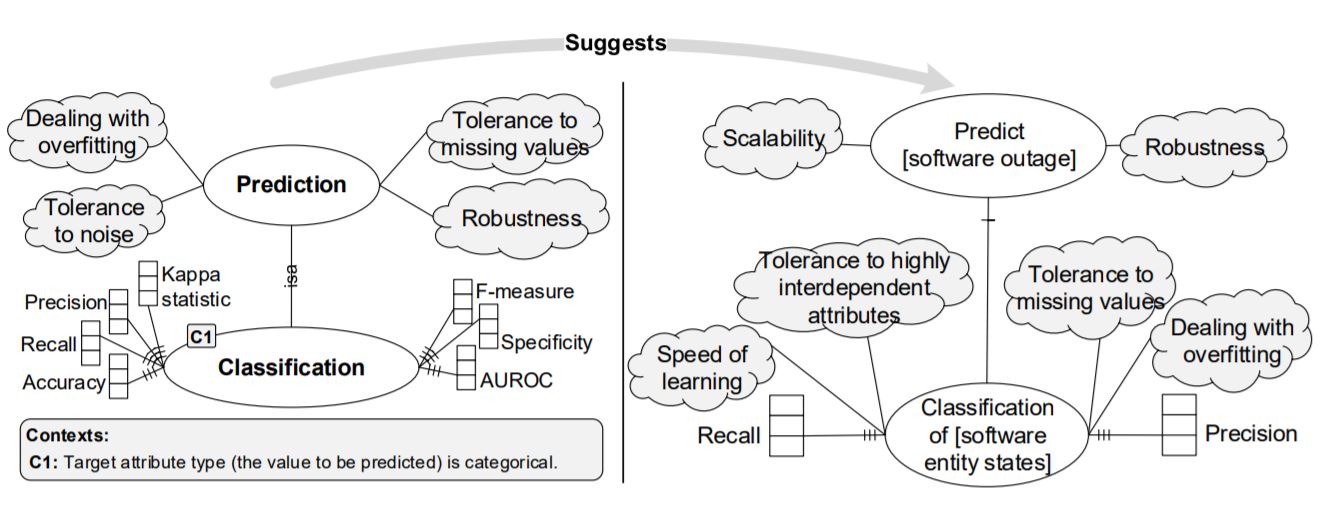 Syntax Guidelines aim to improve the syntactical correctness of the models and correct usage of different modeling elements.
Syntax Guidelines aim to improve the syntactical correctness of the models and correct usage of different modeling elements.
G-14 Direction of Decomposition Links between Strategic Goals and Decision Goals. Direction of Decomposition Links between Strategic Goals and Decision Goals should be only from Strategic Goals towards Decision Goals and not the other way round. In this way, the modeler specifies what decisions need to be made as part of achieving the Strategic Goal at hand. Following figure depicts examples of this guideline:
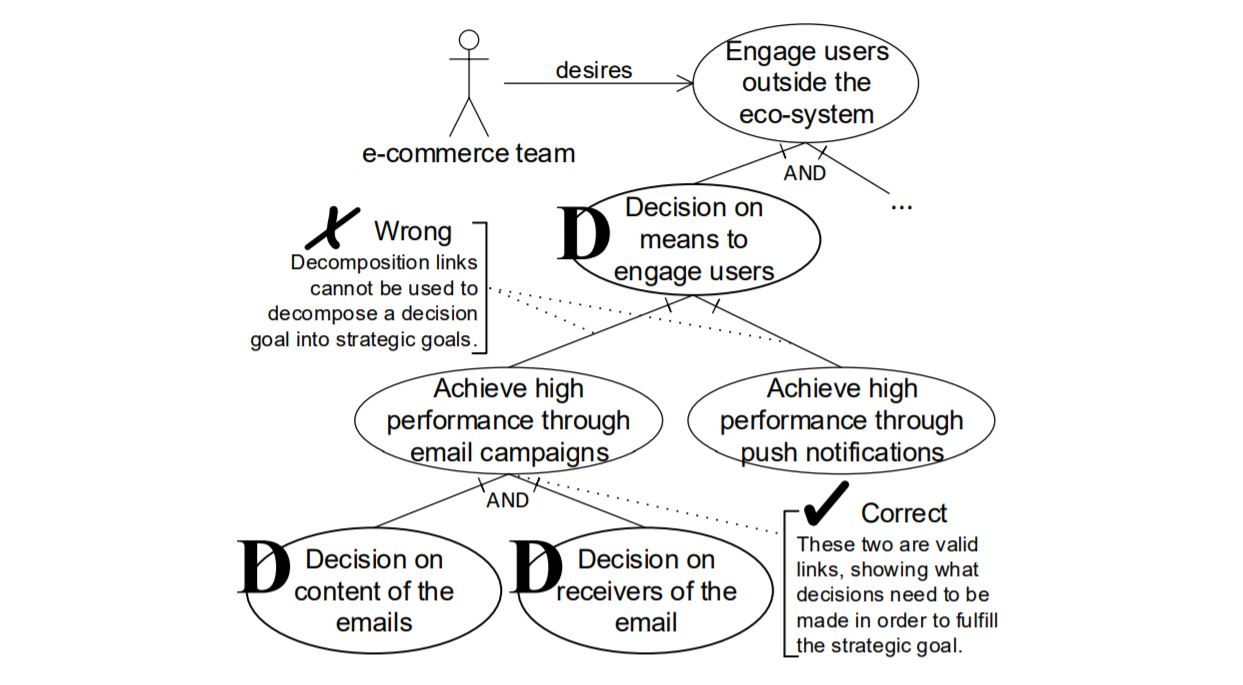 G-15 Source and Destination of Influence Links. Influence Links are not allowed from Decision Goals and Question Goals. Influence Links should only be used to represent the influence of Strategic Goals on Strategic Goals, of Situations on Strategic goals, and of Situations on other Situations. Following figure shows a possible case of wrong use of Influence Links:
G-15 Source and Destination of Influence Links. Influence Links are not allowed from Decision Goals and Question Goals. Influence Links should only be used to represent the influence of Strategic Goals on Strategic Goals, of Situations on Strategic goals, and of Situations on other Situations. Following figure shows a possible case of wrong use of Influence Links:
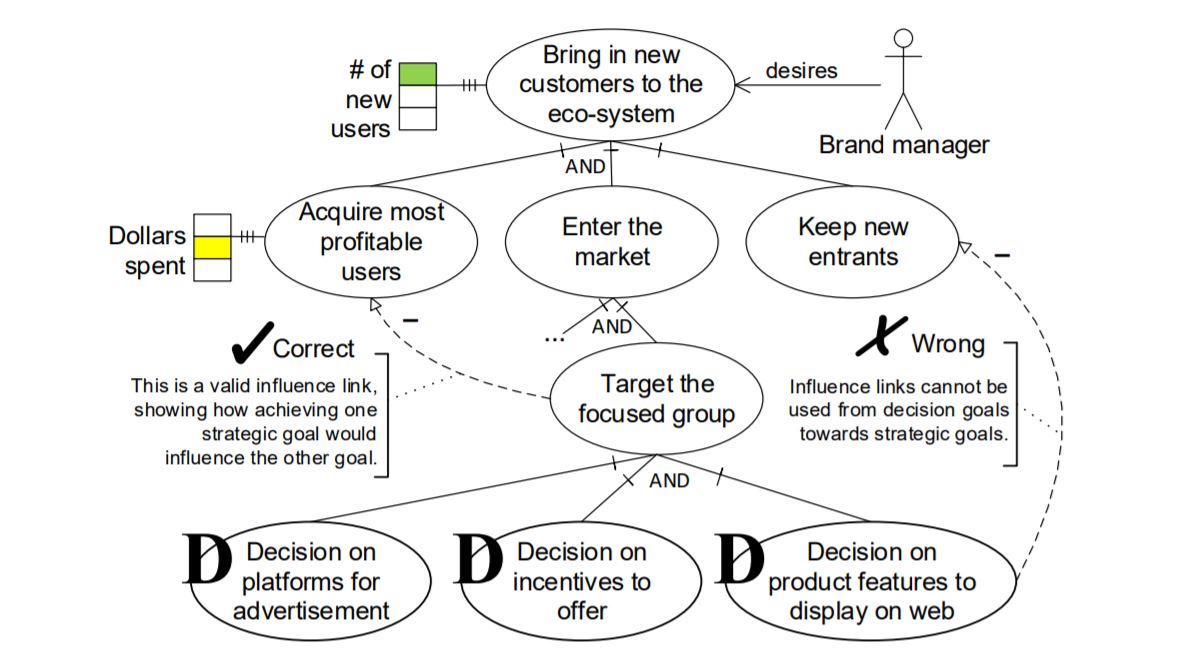 G-16 Linking Insights to Question Goals. At the lowest level of the Business View models, each Question Goal should be connected to at least one Insight element. Those Questions Goals that are not corresponding to any Insight, may either (i) suggesting the need for further decomposition or (ii) suggesting the need for new data tables and attributes in the database (i.e., new data requirements).
G-16 Linking Insights to Question Goals. At the lowest level of the Business View models, each Question Goal should be connected to at least one Insight element. Those Questions Goals that are not corresponding to any Insight, may either (i) suggesting the need for further decomposition or (ii) suggesting the need for new data tables and attributes in the database (i.e., new data requirements).
Naming Guidelines support modelers in picking effective names (labels) for different modeling elements.
G-17 Naming Decision Goals. Use "Decision on <your phrase>" or "<your phrase> decision" styles to label Decision Goals. See examples in the follwoing figure:
 G-18 Naming Question Goals. Name of a Question Goal should start with one of the question type phrases. Avoid naming questions with "would it", "how much", "how many" phrases.
G-18 Naming Question Goals. Name of a Question Goal should start with one of the question type phrases. Avoid naming questions with "would it", "how much", "how many" phrases.
G-19 Naming Insight Elements. Each Insight element is associated with a Type (e.g., predictive model). Name of an Insight Elements should refer to its Type attribute. Following figure provides examples on this:
 G-20 Naming Analytics Goals. At the highest level of the Analytics Design View model, the analytics goal should be named using one of the following styles, depending on the type of analytics needed for the corresponding Question Goal:
G-20 Naming Analytics Goals. At the highest level of the Analytics Design View model, the analytics goal should be named using one of the following styles, depending on the type of analytics needed for the corresponding Question Goal:
Elicitation Guidelines
G-1 Elicitation of Strategic Goals. Strategic business goals can be elicited through a variety of sources and approaches such as interviews, strategic planning documents, mission and vision statements, enterprise policies, and document analysis to extract business goals. Following keywords usually suggest existence of a goal: improve, increase, decrease, achieve, make, maintain, ensure, provide, and accomplish. Following figure shows an example:
G-6 Keywords for Elicitation of Decision Goals. Decision Goals can be elicited from a variety of sources. While reviewing documents or interview notes and recordings, following keywords suggest existence of a Decision Goal: select, determine, pick, choose, resolve, judge, and conclude.
G-7 Keywords for Elicitation of Question Goals. While reviewing documents or interview notes and recordings, following keywords suggest existence of a Question Goal: find, understand, investigate, examine, and know.
G-8 Use of Process Models for Elicitation of Decision Goals. Decisions are made by actors (humans or software agents) at all levels of an enterprise. They are choice points within execution of some ongoing process. If process models are available (e.g., BPMN models), Decision Goals can be elicited from them (e.g., activities that are just before a diverging Gateway). Following figure shows an example of this guideline in an insurance claim approval process:
Syntax Guidelines
G-14 Direction of Decomposition Links between Strategic Goals and Decision Goals. Direction of Decomposition Links between Strategic Goals and Decision Goals should be only from Strategic Goals towards Decision Goals and not the other way round. In this way, the modeler specifies what decisions need to be made as part of achieving the Strategic Goal at hand. Following figure depicts examples of this guideline:
Naming Guidelines
G-17 Naming Decision Goals. Use "Decision on <your phrase>" or "<your phrase> decision" styles to label Decision Goals. See examples in the follwoing figure:
G-19 Naming Insight Elements. Each Insight element is associated with a Type (e.g., predictive model). Name of an Insight Elements should refer to its Type attribute. Following figure provides examples on this:
- Predict [your topic]
- Describe [your topic]
- Prescribe [your topic]